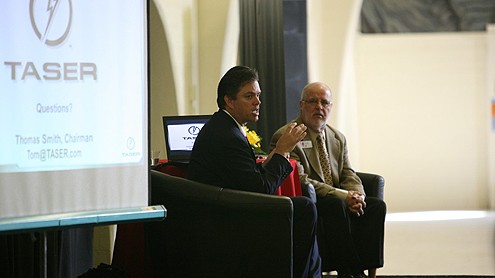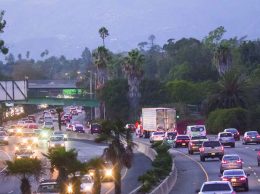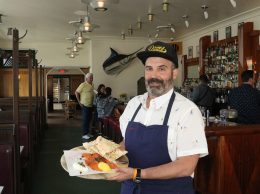Taser to give South Coast jobs market a jolt

Taser CEO Thomas Smith, left, and CSUCI professor Bill Cordeiro at a "Meet the CEO" event on the university campus Friday. Smith said Taser's Carpinteria division is poised for growth. (courtesy photo).
Taser International, the maker of electronic stun guns for law enforcement and private use, sees a huge future for its operations in Carpinteria and expects to add jobs there.
That was the view from Thomas P. Smith, chairman of the Scottsdale, Ariz.-based company, at a “Meet the CEO” forum at CSU Channel Islands Friday afternoon.
Taser manufactures and ships its weapons from Scottsdale, but in 2008 it set up a division in Carpinteria to develop a system that can visually record, from an officer’s eye view, any incident and transmit the data in real time to a server on the Internet. Taser employs 27 people in Carpinteria to produce and refine the Axon system.
The Axon is worn on an officer’s ear like a Bluetooth device. It has a miniature camera, microphone and speaker, enabling it to record an incident that happens while an officer is away from the squad car’s recording system, where Smith said 80 percent of encounters that require the use of force occur.
Until recently, Taser was involved exclusively in producing a varied lineup of its electronic weapons that Smith said have saved 75,000 people from death or serious injury by providing an alternative to the use of lethal force. The Axon equipment, Smith said, is greatly speeding up the pace of investigations of police shootings, saving the public a lot of money in administrative costs and lost time of officers suspended from duty. It can also be a tool for the company to defend itself in lawsuits arising from a small percentage of incidents where people are injured, usually from falls while they are briefly incapacitated.
“We believe that [Axon] is going to be a huge part of our future,” Smith said when the Business Times asked him about growth potential for the Carpinteria operation after the event. “We invested a lot internally in the organic growth of our organization to be prepared to handle that side of it because law enforcement — they’re not technology stalwarts. They’re not the ones who are going to push the envelope on this.”
He said the cost of investigating an officer-involved shooting before Axon has ranged from half a million dollars to $5 million. In the very first case recorded by Axon, he said the inquiry took only 11 days and the officer was only off duty for two days instead of weeks.
Smith said the Axon system, which uses cloud computing to store the huge volume of data generated, will fuel job growth for Taser, which employs 350 workers.
“As the economy starts to turn … we’re going to able to add jobs not only in California but in Arizona and then some regional jobs as well,” Smith said, “to support all of this technology as we need to grow in the government space.”
During an informal session where he fielded questions posed by Bill Cordero, director of the university’s Martin V. Smith School of Business and Economics, the Taser chairman said one of the executive duties he was not prepared for when he built the company with his brother Rick was criticism from the media. He referred to a recent “60 Minutes” program as an example of what he thought was excessive dwelling on a relatively small number of incidents of Taser misuse or collateral injuries.
After the session, the Business Times asked Smith to comment on the criticism by Baltimore’s police commissioner in the TV piece that some officers resort to use of the weapon too quickly.
“I agree with him there’s been cases where it’s been used too many times,” Smith said, “but he’s the one sitting in that seat that can really do something with his officers. I can give him the tools and the technology to watch and monitor that, but at the end of the day, he’s got to be the one doing it.”
“That’s what they do, that’s their living,” he said, “is telling these officers what is the community standard for use in our community and making sure officers are within that standard.”
Smith told an audience of students and community members how he and his brother Rick, the CEO, were inspired in 1993 to find technology to reduce gun violence after two of Rick’s former high school classmates were gunned down in a road rage incident. They envisioned something resembling the phasers used in “Star Trek.”
The company takes its identity from the full name of the weapon they eventually came up with, the Thomas A. Swift Electric Rifle. They hired experts to build upon a Tasertron weapon designed in 1974 by NASA scientist Jack Cover.
Smith explained that Taser works by delivering a high voltage charge to the body at very low amperage. The electric charge causes the muscles in the body to flex and relax 19 times a second, rendering a combative person helpless for about five seconds. The charge is delivered by two electric darts attached to wires and propelled at relatively low velocity by a compressed nitrogen burst.
He said the weapons record every trigger pull with the date, time and duration of the charge. A spray of tiny chaff that identifies that particular weapon is discharged so a Taser can be traced to any specific incident.
Smith said he sees a huge growth potential for the company, with no realistic competitors domestically and a 60 percent U.S. market penetration. The company is battling illegal knockoffs of Tasers overseas, where there is huge potential growth with a current market penetration of 5 percent to 10 percent, he said.












